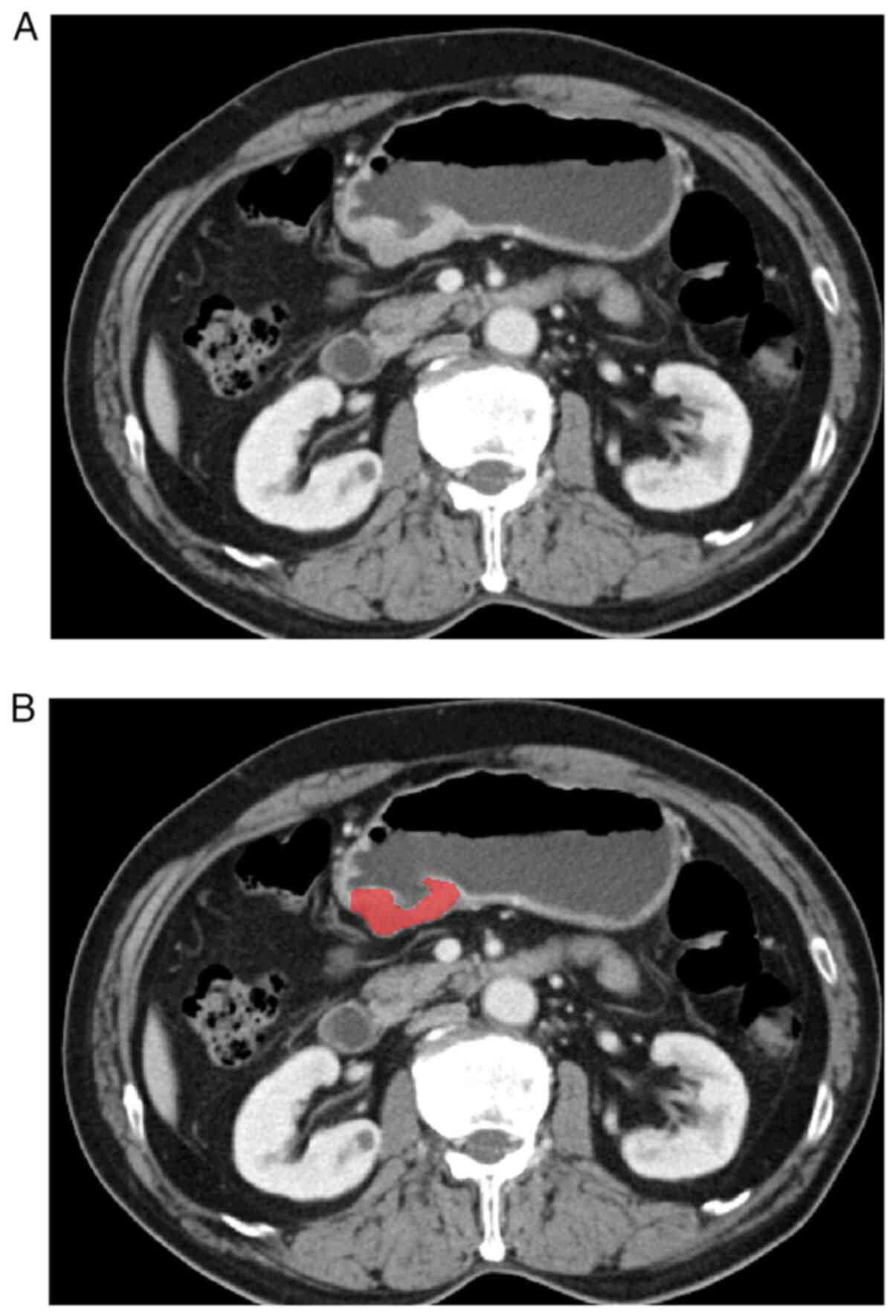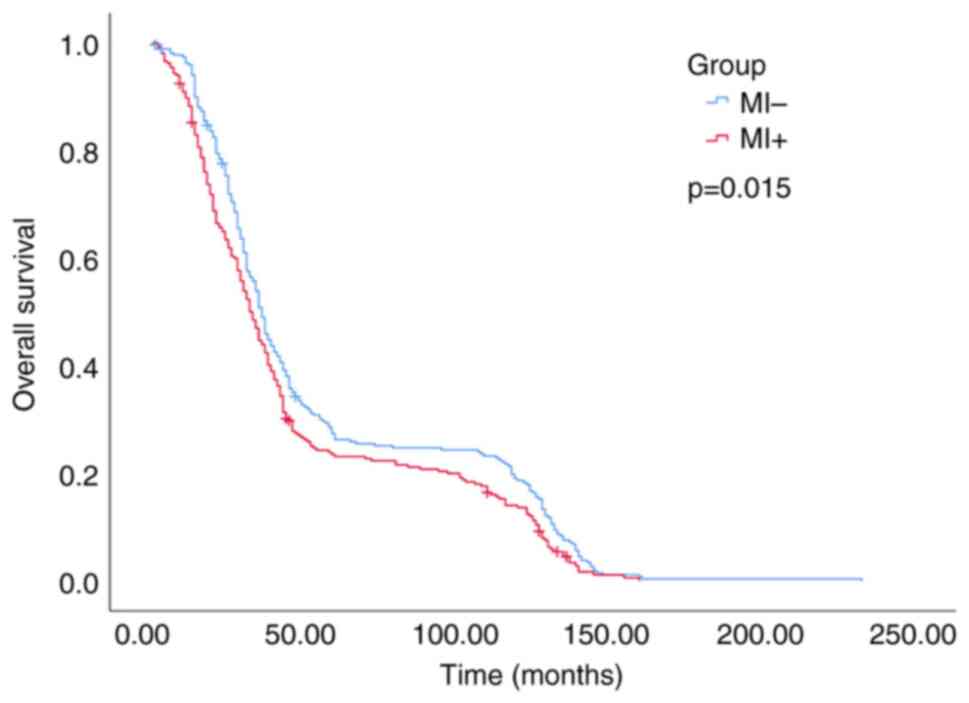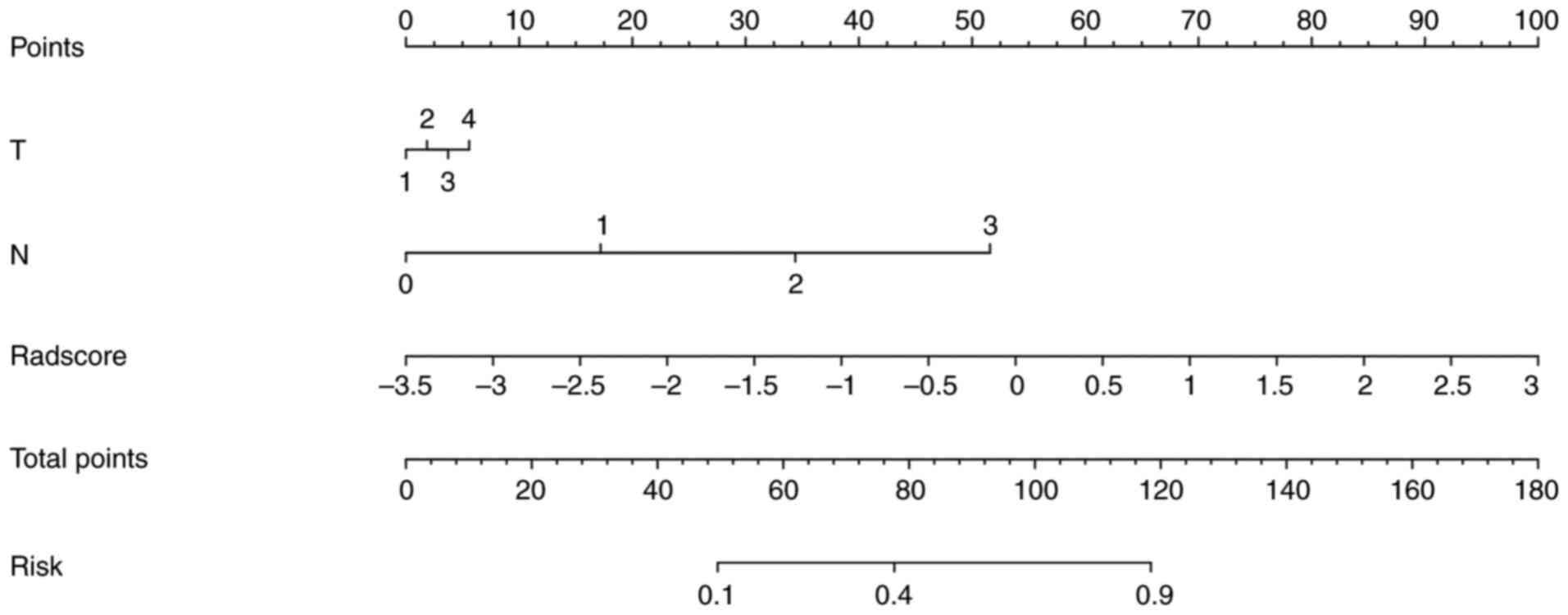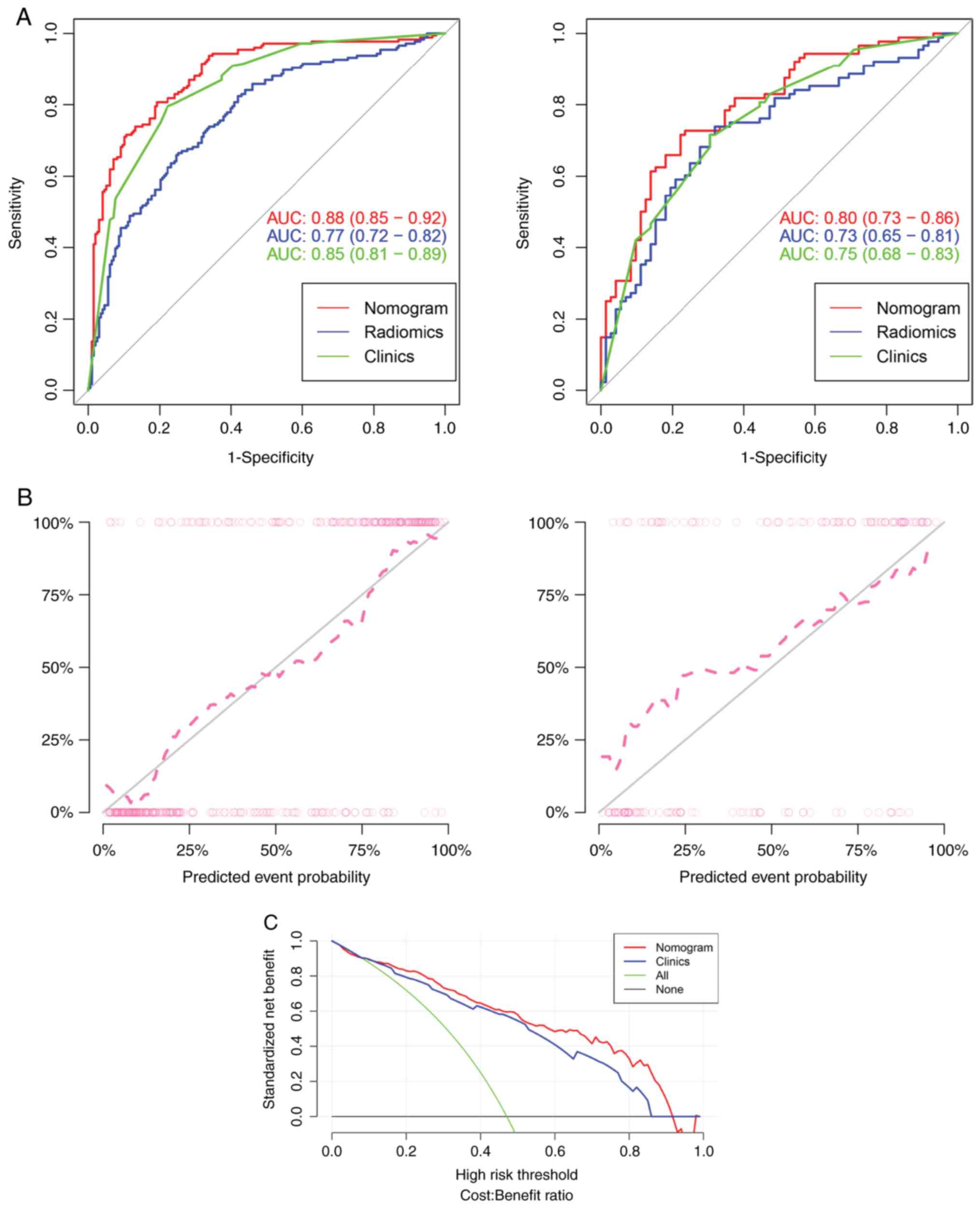|
1
|
Zheng R, Zhang S, Zeng H, Wang S, Sun K,
Chen R, Li L, Wei W and He J: Cancer incidence and mortality in
China, 2016. J Natl Cancer Center. 2:1–9. 2022.PubMed/NCBI View Article : Google Scholar
|
|
2
|
Wang A, Tan Y, Geng X, Chen X and Wang S:
Lymphovascular invasion as a poor prognostic indicator in thoracic
esophageal carcinoma: A systematic review and meta-analysis. Dis
Esophagus. 32:2019.PubMed/NCBI View Article : Google Scholar
|
|
3
|
Hogan J, Chang KH, Duff G, Samaha G, Kelly
N, Burton M, Burton E and Coffey JC: Lymphovascular invasion: A
comprehensive appraisal in colon and rectal adenocarcinoma. Dis
Colon Rectum. 58:547–555. 2015.PubMed/NCBI View Article : Google Scholar
|
|
4
|
Sun Q, Liu T, Liu P, Luo J, Zhang N, Lu K,
Ju H, Zhu Y, Wu W, Zhang L, et al: Perineural and lymphovascular
invasion predicts for poor prognosis in locally advanced rectal
cancer after neoadjuvant chemoradiotherapy and surgery. J Cancer.
10:2243–2249. 2019.PubMed/NCBI View Article : Google Scholar
|
|
5
|
Yuk HD, Jeong CW, Kwak C, Kim HH and Ku
JH: Lymphovascular invasion have a similar prognostic value as
lymph node involvement in patients undergoing radical cystectomy
with urothelial carcinoma. Sci Rep. 8(15928)2018.PubMed/NCBI View Article : Google Scholar
|
|
6
|
Epstein JD, Kozak G, Fong ZV, He J, Javed
AA, Joneja U, Jiang W, Ferrone CR, Lillemoe KD, Cameron JL, et al:
Microscopic lymphovascular invasion is an independent predictor of
survival in resected pancreatic ductal adenocarcinoma. J Surg
Oncol. 116:658–664. 2017.PubMed/NCBI View Article : Google Scholar
|
|
7
|
Fujikawa H, Koumori K, Watanabe H, Kano K,
Shimoda Y, Aoyama T, Yamada T, Hiroshi T, Yamamoto N, Cho H, et al:
The clinical significance of lymphovascular invasion in gastric
cancer. In Vivo. 34:1533–1539. 2020.PubMed/NCBI View Article : Google Scholar
|
|
8
|
Maniaci A, Fakhry N, Chiesa-Estomba C,
Lechien JR and Lavalle S: Synergizing ChatGPT and general AI for
enhanced medical diagnostic processes in head and neck imaging. Eur
Arch Otorhinolaryngol. 281:3297–3298. 2024.PubMed/NCBI View Article : Google Scholar
|
|
9
|
Yardımcı AH, Koçak B, Turan Bektaş C, Sel
İ, Yarıkkaya E, Dursun N, Bektaş H, Usul Afşar Ç, Gürsu RU and
Kılıçkesmez Ö: Tubular gastric adenocarcinoma: Machine
learning-based CT texture analysis for predicting lymphovascular
and perineural invasion. Diagn Interv Radiol. 26:515–522.
2020.PubMed/NCBI View Article : Google Scholar
|
|
10
|
Hirabayashi S, Kosugi S, Isobe Y,
Nashimoto A, Oda I, Hayashi K, Miyashiro I, Tsujitani S, Kodera Y,
Seto Y, et al: Development and external validation of a nomogram
for overall survival after curative resection in serosa-negative,
locally advanced gastric cancer. Ann Oncol. 25:1179–1184.
2014.PubMed/NCBI View Article : Google Scholar
|
|
11
|
Wang PL, Xiao FT, Gong BC, Liu FN and Xu
HM: A nomogram for predicting overall survival of gastric cancer
patients with insufficient lymph nodes examined. J Gastrointest
Surg. 21:947–956. 2017.PubMed/NCBI View Article : Google Scholar
|
|
12
|
Vickers AJ, Cronin AM, Elkin EB and Gonen
M: Extensions to decision curve analysis, a novel method for
evaluating diagnostic tests, prediction models and molecular
markers. BMC Med Inform Decis Mak. 8(53)2008.PubMed/NCBI View Article : Google Scholar
|
|
13
|
Smyth EC, Nilsson M, Grabsch HI, van
Grieken NC and Lordick F: Gastric cancer. Lancet. 396:635–648.
2020.PubMed/NCBI View Article : Google Scholar
|
|
14
|
Jiang Y, Zhang Q, Hu Y, Li T, Yu J, Zhao
L, Ye G, Deng H, Mou T, Cai S, et al: ImmunoScore signature: A
prognostic and predictive tool in gastric cancer. Ann Surg.
267:504–513. 2018.PubMed/NCBI View Article : Google Scholar
|
|
15
|
Zhang CD, Ning FL, Zeng XT and Dai DQ:
Lymphovascular invasion as a predictor for lymph node metastasis
and a prognostic factor in gastric cancer patients under 70 years
of age: A retrospective analysis. Int J Surg. 53:214–220.
2018.PubMed/NCBI View Article : Google Scholar
|
|
16
|
Goto A, Nishikawa J, Hideura E, Ogawa R,
Nagao M, Sasaki S, Kawasato R, Hashimoto S, Okamoto T, Ogihara H,
et al: Lymph node metastasis can be determined by just tumor depth
and lymphovascular invasion in early gastric cancer patients after
endoscopic submucosal dissection. Eur J Gastroenterol Hepatol.
29:1346–1350. 2017.PubMed/NCBI View Article : Google Scholar
|
|
17
|
Wu L, Liang Y, Zhang C, Wang X, Ding X,
Huang C and Liang H: Prognostic significance of lymphovascular
infiltration in overall survival of gastric cancer patients after
surgery with curative intent. Chin J Cancer Res. 31:785–796.
2019.PubMed/NCBI View Article : Google Scholar
|
|
18
|
Xue L, Chen XL, Lin PP, Xu YW, Zhang WH,
Liu K, Chen XZ, Yang K, Zhang B, Chen ZX, et al: Impact of
capillary invasion on the prognosis of gastric adenocarcinoma
patients: A retrospective cohort study. Oncotarget. 7:31215–31225.
2016.PubMed/NCBI View Article : Google Scholar
|
|
19
|
Choi SW, Cho HH, Koo H, Cho KR, Nenning
KH, Langs G, Furtner J, Baumann B, Woehrer A, Cho HJ, et al:
Multi-habitat radiomics unravels distinct phenotypic subtypes of
glioblastoma with clinical and genomic significance. Cancers
(Basel). 12(1707)2020.PubMed/NCBI View Article : Google Scholar
|
|
20
|
Huang Y, Liu Z, He L, Chen X, Pan D, Ma Z
and Liang C, Tian J and Liang C: Radiomics signature: A potential
biomarker for the prediction of disease-free survival in early
stage (I or II) non-small cell lung cancer. Radiology. 281:947–957.
2016.PubMed/NCBI View Article : Google Scholar
|
|
21
|
Chen X, Yang Z, Yang J, Liao Y, Pang P,
Fan W and Chen X: Radiomics analysis of contrast-enhanced CT
predicts lymphovascular invasion and disease outcome in gastric
cancer: a preliminary study. Cancer Imaging. 20(24)2020.PubMed/NCBI View Article : Google Scholar
|
|
22
|
Peng H, Long F and Ding C: Feature
selection based on mutual information: criteria of max-dependency,
max-relevance, and min-redundancy. IEEE Trans Pattern Anal Mach
Intell. 27:1226–1238. 2005.PubMed/NCBI View Article : Google Scholar
|
|
23
|
Hepp T, Schmid M, Gefeller O, Waldmann E
and Mayr A: Approaches to regularized regression-A comparison
between gradient boosting and the Lasso. Methods Inf Med.
55:422–430. 2016.PubMed/NCBI View Article : Google Scholar
|



















